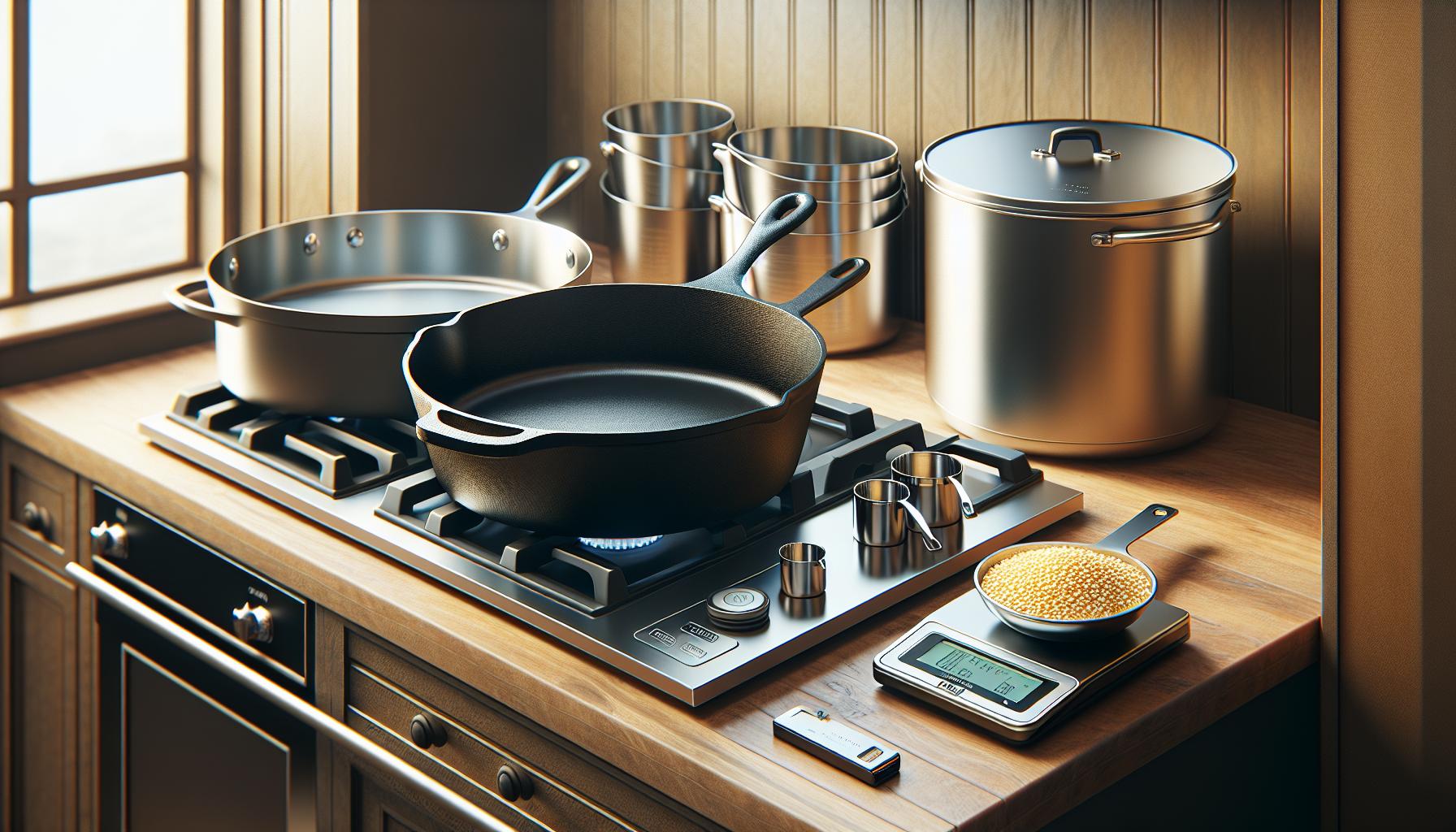Cornmeal transforms ordinary dishes into extraordinary comfort food with its versatile nature and distinctive texture. From crispy-crusted pizzas to fluffy cornbread this humble ingredient has become a kitchen superhero in countless recipes across the globe.
Whether you’re a seasoned chef or a curious home cook mastering cornmeal cooking techniques can elevate your culinary game to new heights. It’s not just about mixing it with water – there’s an art to achieving that perfect golden crust polenta or those mouthwatering hush puppies that’ll make your dinner guests beg for seconds.
Join us as we explore the essential techniques that’ll turn this simple grain into delectable masterpieces. Trust us your taste buds will thank you later and you’ll never look at cornmeal the same way again.
Cornmeal Cooking Techniques
Cornmeal consists of dried corn kernels ground into a powder through stone-grinding or steel roller milling processes. Different grinding methods create distinct textures suited for specific culinary applications.
Fine vs Medium vs Coarse Grind
Cornmeal comes in three primary grinds that serve unique cooking purposes:
- Fine cornmeal resembles wheat flour in texture, measuring less than 1mm in particle size. This grind creates smooth, tender cornbread batters.
- Medium cornmeal particles measure 1-2mm, offering the most versatile option for cornmeal recipes. Professional chefs prefer medium grind for polenta dishes.
- Coarse cornmeal contains 2-3mm granules that produce rustic textures. Southern-style grits recipes typically call for coarse cornmeal.
- Yellow cornmeal comes from yellow dent corn, containing high levels of beta carotene. This variety delivers a robust corn flavor with nutty undertones.
- White cornmeal derives from white corn kernels, providing a more delicate taste profile. Southern bakers often select white cornmeal for traditional cornbread recipes.
| Type | Particle Size | Best Uses |
|---|---|---|
| Fine | <1mm | Cornbread, cakes |
| Medium | 1-2mm | Polenta, breading |
| Coarse | 2-3mm | Grits, cornmeal mush |
Essential Tools for Cooking With Cornmeal

Professional cornmeal cooking demands specific equipment to achieve consistent textures and perfect results. The right tools transform basic cornmeal into golden polenta, crispy cornbread or perfectly fried hush puppies.
Best Pots and Pans
Heavy-bottom stainless steel or cast iron pots excel at cornmeal cooking by distributing heat evenly. A 4-quart saucepan with tall sides prevents polenta splatter while cooking. Cast iron skillets measuring 10-12 inches create the signature crust on Southern cornbread. Dutch ovens maintain steady temperatures for deep-frying cornmeal-based foods like hush puppies. Nonstick surfaces reduce sticking when cooking delicate cornmeal preparations such as johnnycakes.
Mixing and Measuring Equipment
Digital kitchen scales provide precise measurements for consistent cornmeal-to-liquid ratios. Glass measuring cups with clear markings ensure accurate liquid portions. Stainless steel whisks prevent lumps in cornmeal batters. Wooden spoons feature long handles for stirring thick mixtures safely. Heat-resistant silicone spatulas fold ingredients without scratching cookware. Fine-mesh strainers sift cornmeal to remove larger particles for smoother textures. Standing mixers with paddle attachments blend cornmeal batters efficiently for larger recipes.
Traditional Cornmeal Preparation Methods

Traditional cornmeal preparation techniques enhance flavor development through controlled hydration methods. These time-tested approaches create optimal textures for various cornmeal dishes ranging from silky polenta to crispy cornbread.
The Soaking Method
The soaking method involves combining cornmeal with cold water before cooking. A 3:1 ratio of liquid to cornmeal creates the ideal consistency for most preparations. Adding cornmeal to room temperature water prevents clumping compared to direct heat application. This technique requires 30 minutes of soaking time for medium grind cornmeal or 60 minutes for coarse varieties. Professional chefs integrate this method into restaurant kitchens because it produces consistently smooth results. Soaking activates natural enzymes in cornmeal, resulting in enhanced corn flavor development.
The Direct Heat Method
Direct heat cooking combines cornmeal with boiling liquid in a single step. Incorporating cornmeal in a steady stream while whisking prevents lumps from forming during the cooking process. Professional kitchens maintain a temperature of 185°F (85°C) throughout the cooking duration. Medium-grind cornmeal requires 15-20 minutes of constant stirring over direct heat. Cast iron or heavy-bottomed pots distribute heat evenly across the cooking surface. This method creates firmer textures ideal for polenta cakes or crispy cornmeal preparations.
Popular Cornmeal Dishes Around the World

Cornmeal serves as a cornerstone ingredient in traditional dishes across diverse culinary cultures. Each region transforms this versatile grain into distinctive specialties that reflect local cooking methods and flavor preferences.
Southern-Style Cornbread
Southern cornbread emerges golden crisp from cast-iron skillets in countless American kitchens. Traditional recipes combine white cornmeal with buttermilk in an 8:5 ratio, creating a dense crumb structure without added sugar. Expert bakers preheat their skillets at 450°F for 10 minutes before adding 2 tablespoons of bacon fat, ensuring the signature crusty bottom. Atlanta-based chefs often incorporate cream-style corn plus diced jalapeños, while Tennessee cooks favor a simple mixture that lets the corn flavor shine through.
Italian Polenta
Italian polenta transforms coarse yellow cornmeal into a creamy, versatile dish through slow cooking techniques. Authentic preparation requires stirring cornmeal into simmering water at a 4:1 water-to-cornmeal ratio for 45 minutes. Northern Italian regions serve polenta as a base for rich meat ragùs or mushroom sauces. Lombardy chefs cut cooled polenta into squares, grill them until crispy, then top with Gorgonzola cheese. Restaurant kitchens prepare polenta in copper pots called paioli, maintaining consistent heat distribution.
Mexican Tamales
Mexican tamales showcase masa harina (fine cornmeal) steamed within corn husks or banana leaves. Traditional recipes blend masa with lard in a 3:1 ratio, whipping until light plus airy. Central Mexican cooks fill their tamales with shredded pork in red chile sauce, while Oaxacan varieties feature mole negro. Street vendors steam their tamales in large metal pots called tamaleras for 90 minutes. Skilled tamaleras (tamale makers) layer corn husks in a crisscross pattern, creating optimal steam circulation during cooking.
Common Mistakes to Avoid When Cooking Cornmeal
Successful cornmeal cooking requires attention to detail and proper technique. Understanding these common pitfalls enhances the quality of cornmeal-based dishes.
Temperature Control Issues
Temperature fluctuations create inconsistent textures in cornmeal dishes. Cooking polenta at high temperatures leads to scorching at the bottom while leaving lumps on top. Medium-low heat maintains even cooking throughout the mixture. A heavy-bottomed pot distributes heat evenly across the cooking surface, preventing hot spots that cause burning. Digital thermometers indicate optimal temperatures: 185°F for polenta cooking, 350°F for cornbread baking, and 375°F for hush puppy frying. Maintaining steady temperatures produces smooth, fully cooked results without raw spots or burnt edges.
Liquid Ratio Problems
Incorrect liquid-to-cornmeal ratios result in either soupy mixtures or dry, crumbly textures. Fine cornmeal requires a 3:1 liquid-to-cornmeal ratio, while coarse variants need 4:1 ratios for proper hydration. Adding liquids gradually prevents lumping during the cooking process. Room temperature liquids incorporate more smoothly than cold ones. Measuring tools ensure precise ratios: 1 cup of medium-grind cornmeal absorbs 3 cups of liquid for standard polenta, while cornbread batters use 2 cups of liquid per cup of cornmeal. Adjusting these ratios based on cornmeal grind size creates optimal consistency.
Remarkable Dishes
Mastering cornmeal cooking techniques opens up a world of culinary possibilities. From achieving the perfect polenta consistency to creating golden-crusted cornbread this versatile ingredient deserves a prominent place in every kitchen. Understanding proper tools temperatures and preparation methods ensures consistently delicious results.
Armed with these essential techniques home cooks can confidently explore traditional recipes from around the globe. Whether it’s Southern comfort food Italian classics or Mexican specialties cornmeal’s adaptability shines through. It’s time to embrace this humble ingredient and discover the remarkable dishes it can create.

